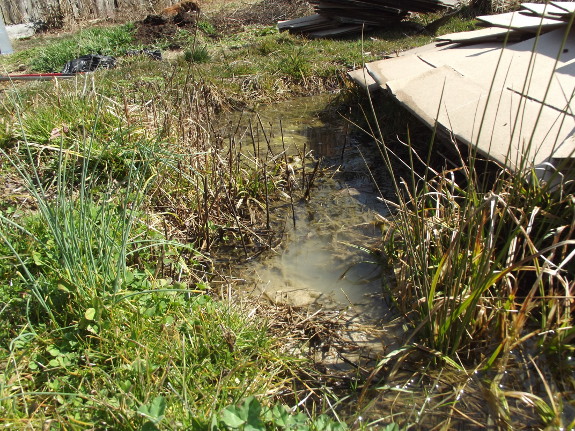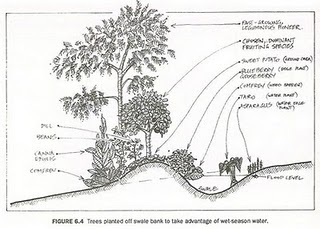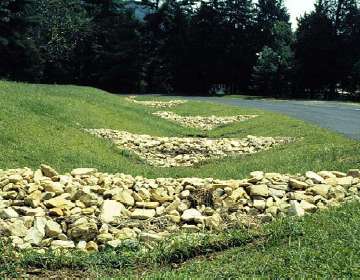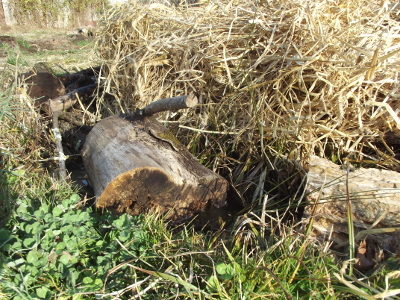
Swales in wet climates

One of my early projects
in the forest
garden was to build mounds
and swales in an
attempt to deal with waterlogged soil. The mounds did their job
well --- they raised plants up high enough out of the water that they
survived. The swales were more problematic.
 The permaculture literature
discusses swales as used in dry climates. There, swales capture
runoff so the precious liquid doesn't disappear onto the neighbor's
property. A dry climate swale is basically a linear, wet-weather
pond that runs along a contour line, filling up during rains, then
releasing the water into the surrounding area over the days and weeks
that follow. Bill Mollison and other permaculture practitioners
plant moisture-loving trees and shrubs on the downhill side of these
swales for free irrigation.
The permaculture literature
discusses swales as used in dry climates. There, swales capture
runoff so the precious liquid doesn't disappear onto the neighbor's
property. A dry climate swale is basically a linear, wet-weather
pond that runs along a contour line, filling up during rains, then
releasing the water into the surrounding area over the days and weeks
that follow. Bill Mollison and other permaculture practitioners
plant moisture-loving trees and shrubs on the downhill side of these
swales for free irrigation.
 In wet climates, a different
kind of swale is used to channel runoff across flood-tolerant
vegetation, cleaning the water and preventing erosion. In this
case, swales are built perpendicular to a slope to keep water moving,
then check-dams are added at intervals to slow the water down and help
silt drop out. Wet climate swales are often located next to roads
or parking lots, as is shown in this photo, and they allow runoff to
sink into non-waterlogged soil.
In wet climates, a different
kind of swale is used to channel runoff across flood-tolerant
vegetation, cleaning the water and preventing erosion. In this
case, swales are built perpendicular to a slope to keep water moving,
then check-dams are added at intervals to slow the water down and help
silt drop out. Wet climate swales are often located next to roads
or parking lots, as is shown in this photo, and they allow runoff to
sink into non-waterlogged soil.
You'll notice that both
types of swales capture water and let it sink into the ground.
The big difference in function is that dry climate swales can be built
in ground that doesn't "perk" since the goal is to make the water stick
around as long as possible. Wet climate swales are built on
well-drained soil with the goal of getting that runoff into the
groundwater as quickly as possible.
I wish I'd realized the
difference between dry climate and wet
climate water management when I installed my swales, because I
learned the hard way that creating a dry climate swale in our neck of
the woods can turn wet ground into a marsh. Marshes have their
place, but a marshy ditch in the middle of a "lawn" becomes a mowing
hazard quickly. Rather than ruin the lawn mower, Mark skipped
mowing these spots, with predictable
results.
 As part of my campaign to
streamline maintenance of the forest garden, I'm starting to build the
swales back up to ground level. I figure rotten logs in the holes
will capture and hold water, releasing it to the nearby plants during
dry spells. Once I hunt down enough logs to fill the swales up,
I'll mulch over top so that that area won't need to be mowed at all
this year.
As part of my campaign to
streamline maintenance of the forest garden, I'm starting to build the
swales back up to ground level. I figure rotten logs in the holes
will capture and hold water, releasing it to the nearby plants during
dry spells. Once I hunt down enough logs to fill the swales up,
I'll mulch over top so that that area won't need to be mowed at all
this year.
Of course, even my
improved swales hold onto water rather than draining it out of the
waterlogged area. I might eventually turn to ditching to deal
with that issue, but for now, I think I can take advantage of the extra
water. I'll just keep building up so that roots don't drown.
Want more in-depth information? Browse through our books.
Or explore more posts by date or by subject.
About us: Anna Hess and Mark Hamilton spent over a decade living self-sufficiently in the mountains of Virginia before moving north to start over from scratch in the foothills of Ohio. They've experimented with permaculture, no-till gardening, trailersteading, home-based microbusinesses and much more, writing about their adventures in both blogs and books.
Want to be notified when new comments are posted on this page? Click on the RSS button after you add a comment to subscribe to the comment feed, or simply check the box beside "email replies to me" while writing your comment.

Hi Anna,
Can you recommend any resources on how to build swales in wet climates? My residential neighborhood is on a hillside, but my house sits in a little dip in the hill. Whenever it rains, the water flows down the hill and stops in my yard for a bit before continuing on. For about three weeks out of the year, I have a pond for a yard. Unfortunately, this tends to occur right around when I should be planting a veggie garden, so I haven't been able to really grow any food, and I'd like to remedy that situation.
Thank you!
Leslie --- There's a lot of technical information out there from agencies that build swales to treat greywater coming off huge parking lots. I suspect you'd need to tweak it a bit to match a backyard environment, but here are a couple of sources to get you started:
http://pubs.ext.vt.edu/BSE/BSE-4/BSE-4.html --- This is for wet swales, where the bottom of the swale can sit below the water level all the time. (You might not be wet enough for that.)
http://pubs.ext.vt.edu/BSE/BSE-20/BSE-20.html --- Grass channels might be more appropriate for your area.
If you find better sources, or make your own swale, I hope you'll come back and share your experiences!
We live on a mountain with hard clay soil. There are areas that have a natural water way for rain to continue on its journey. But, because our summers are so dry, I need to stop this rain from leaving the top so that I can ulilize the water with my plants.
This is the first year I have incorporated hulgeculture into my garden. I think I have gone kind of crazy. I am runnig a hulgle bed all along the edge of the hill and using large tree limbs cut from the trees that shade that area. Then I have a friend that will give me wood shavings from his saw mill and leaves that I rake up in the forest. If I have to I will fill it in with straw. Then dirt and plant in it. So far I have about 60' of hugle pile started and another 40' more that I can put in.
I am excited about this project.
Eric --- I think I remember reading on your blog when you ate the cattail flowers. I want to try them out this year, if I can remember! We actually have a bunch of wild cattails just up the holler, so no need to plant them here.
A friend of mine grew cranberries a few years ago and got such low yields that she ripped them out. I may still experiment with them sometime, though, because I really like cranberries. But I think we're a bit too warm (or something?) for them to do well.
Mona --- It sounds like you may be a good candidate for dry climate swales! Combined with your awesome hugelkultur experiment, you may soon have created an oasis.